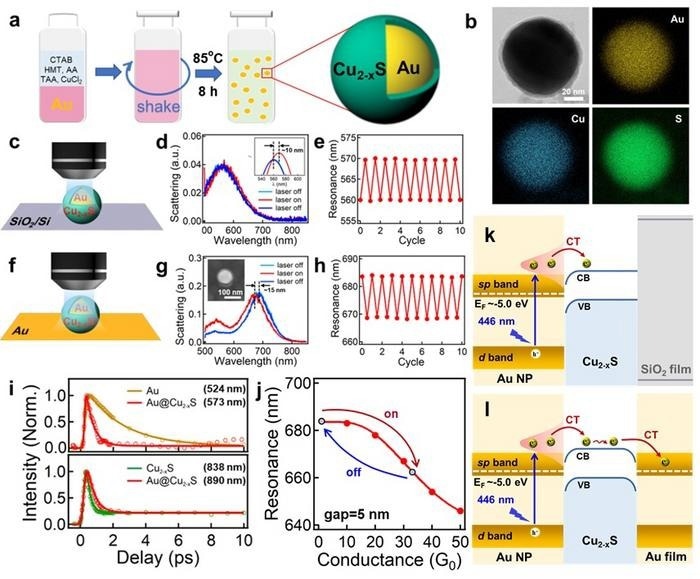Reviewed by Lexie CornerMay 20 2024
A recent study in the National Science Review detailed the dynamic and reversible optical modulation of surface plasmons. This modulation is achieved through the transport of hot carriers. This study was led by Professor Ding Tao's research group at Wuhan University, along with Professor Hongxing Xu, Associate Professor Li Zhou, Research Professor Ti Wang, as well as Professor Ququan Wang from the Southern University of Science and Technology.
 Au@Cu2-xS core-shell particles for rapid and reversible control of plasmons and analysis of the mechanism. Image Credit: Science China Press
Au@Cu2-xS core-shell particles for rapid and reversible control of plasmons and analysis of the mechanism. Image Credit: Science China Press
Future photonic processors and all-optical neural networks are built on the foundation of photonic computation, storage, and communication. Due to their extremely small mode volume and high response speed, nanoscale plasmons are crucial to the integration of photonic devices.
However, their stability and operability are severely impaired, and they are frequently incompatible with current optoelectronics due to the limits of materials and basic principles in many earlier systems.
This research combines the optoelectronic manipulation of semiconductors with the high-speed response of metal nanoplasmons. It does this by optically stimulating the hot electrons, which, in turn, modifies the conductivity of the nanogaps and the charge density in gold, resulting in reversible and rapid switching of the plasmon resonances. It, therefore, offers a significant optoelectronic switch prototype for use in nanophotonic processors.
First, Au@Cu2-xS core-shell nanoparticles were synthesized by the study team, and their microstructure was evaluated. According to the experimental findings, Au@Cu2-xS core-shell nanoparticles with varying shell thicknesses can be produced using the sol-gel approach, which makes them the perfect carrier for achieving ultrafast dynamic control of nanoscale plasmons.
Au@Cu2-xS nanoparticles on various substrates can achieve ultrafast dynamic modulation. When exposed to laser light, the Au@Cu2-xS nanoparticles' plasmonic resonance peak on the SiO2/Si substrate shows a red shift. In contrast, the Au@Cu2-xS nanoparticles' plasmonic resonance peak on the Au substrate shows a blue shift.
Resonance peaks revert to their places when the laser is switched off. Every optoelectronic tuning method has demonstrated controllability, reversibility, and comparatively quick response times. The optical excitation of the Au@Cu2-xS plasmonic composite structure can result in the hot electrons in Au transferring to Cu2-xS, which lowers Au's electron density and redshifts the Localized Surface Plasmon Resonance (LSPR).
This is supported by Transient Absorption (TA) spectra and theoretical calculations. On the other hand, hot electrons can be transferred from the Au@Cu2-xS to the Au substrate when the Au@Cu2-xS is positioned on an Au substrate (NPoM structure). This increases the conductivity of the nanogap and results in a blue shift of the linked plasmon polaritons.
This hot carrier transport plasmonic control approach is especially well-suited for optoelectronic device integration, offering prototype devices for photonic interconnection and computation.
Journal Reference:
Yao, J., et al. (2023) Optoelectronic tuning of plasmon resonances via optically modulated hot electrons. National Science Review. doi.org/10.1093/nsr/nwad280.